| catadioptric telescopes |
|
So far, we have been considering telescopes composed of only mirrors, or only lenses. It is possible, of course, to combine mirrors and lenses; such telescope designs are known as catadioptric and they offer certain advantages over refractors and reflectors for some applications. We shall look at three different types of catadioptric telescope here: the Schmidt, the Schmidt-Cassegrain and the Maksutov, noting that many other types exist (e.g. the modified Dall-Kirkham).
Schmidt telescopes
Due to the coma inherent in Cassegrain telescopes, the field of view tends to be limited to tens of arcminutes. This can be extended to a degree or so using a Ritchey-Chretien design, but fields of view significantly greater than this are almost impossible to achieve with these designs.
In 1930, the Estonian-born optical designer, Bernhard Schmidt, proposed a catadioptric telescope design capable of imaging fields of more than ten degrees across. He decided to use a concave spherical primary, but with an entrance aperture (or aperture stop) placed at the centre of curvature of the mirror (see figure 23). By symmetry, the spherical mirror then treats every point in the field the same, so all rays are effectively "on-axis" and are imaged onto a curved focal plane. (You can think about this in terms of the shape of the mirror seen by beams coming from different angles; at the centre of curvature, they all see the same spherical shape, whereas closer to the mirror the shape of the mirror depends on the off-axis angle.) Such a design therefore eliminates all off-axis aberrations such as coma and astigmatism. The drawback is that spherical mirrors, as we have already seen, suffer from spherical aberration. Schmidt's design corrects for this using a thin (so it absorbs little light) lens placed at the centre of curvature, thereby allowing wide-field, almost aberration-free views.
| figure 23: |
A schematic of a Schmidt telescope. The corrector lens is placed at
the centre of curvature of the primary mirror. The focal
length, F, is given by half the radius of
curvature, R.
|
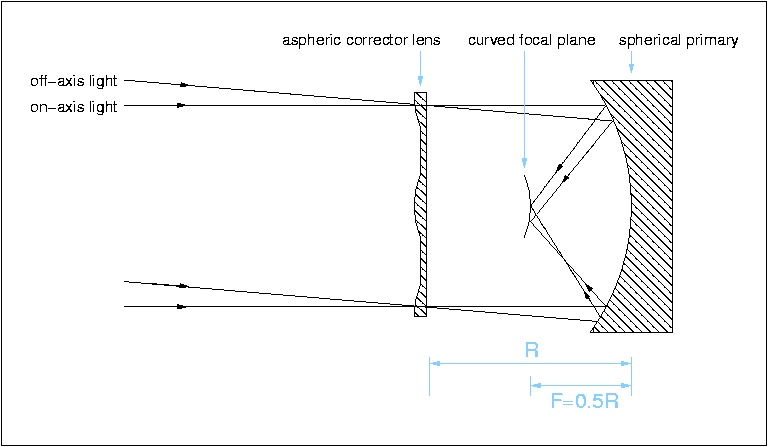
A schematic of a Schmidt telescope is shown in figure 23. In practice, unfortunately, Schmidt telescopes are not completely aberration free. The thin corrector lens, which is usually aspherical, introduces some chromatic aberration and residual spherical aberration. It is also impossible to achieve the idealised scenario of all rays effectively emanating from the centre of curvature by using a finite-sized aperture, hence some off-axis aberrations are still present. The curved focal plane also introduces difficulties, requiring either the use of a field-flattening lens or actually bending the detector (e.g. a photographic plate) to the correct shape. Despite these drawbacks, Schmidt telescopes provide excellent images over a very wide field of view and they were used throughout the 20th-century to perform a number of important sky surveys.
A well known example of a Schmidt design is shown on the left-hand side of figure 24 - the UK Schmidt Telescope (UKST) in New South Wales. This telescope has a corrector lens with a diameter of 1.24m. This defines the aperture of the telescope, but the primary mirror is actually far larger (1.83m) in order to collect light from a wide angle on the sky. The requirement for a wide field of view equates to a large platescale and hence a short focal length; the focal length of the UKST is only 3.07m, i.e. the telescope is a very fast f/2.5. With this design, 6.4o x 6.4o of the sky can be imaged in a single exposure.
The largest Schmidt telescope in the world has an aperture of 1.34m, only slightly larger than the UKST. It is unlikely that a bigger one will ever be built, for the same reason that the diameter of the biggest refractor in the world is only 1.0m: the corrector is a lens and a much larger size would be difficult and expensive to make, and impossible to hold rigidly by its rim. Another problem is the length of the tube required, which the design dictates must always be approximately twice the focal length of the primary. The inaccessible position and awkward shape of the focal plane also makes the use of modern instrumentation difficult. For this reason, one of the latest sky surveys, the Sloan Digital Sky Survey (SDSS; right-hand side of figure 24), uses a 2.5m Ritchey-Chretien design with a lens-based corrector placed close to the focal plane, providing a field of view of 3o. Although the SDSS telescope takes over 4 times as many pointings to cover the same patch of sky as the UKST, it is the only feasible way of using a larger aperture telescope to survey the sky for the faintest objects.
| figure 24: |
Left: Photograph
of the 1.24m UK Schmidt Telescope in New South Wales. Right: Photograph of the 2.5m Sloan Digital Sky Survey telescope in New Mexico.
|
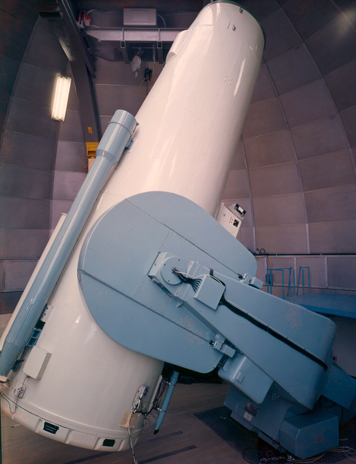
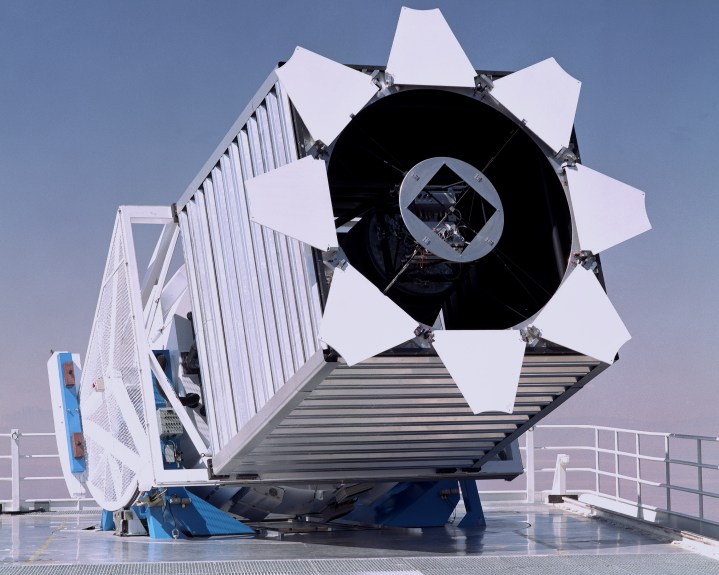
Schmidt-Cassegrain telescopes
The Schmidt-Cassegrain is not a telescope you will find in major research observatories, but it is arguably the most widespread design used in the amateur telescope market. As its name implies, it is a hybrid of the Schmidt and Cassegrain designs. The light passes through a corrector lens and reflects off a concave spherical primary, just like in a Schmidt telescope. The focal ratio of the primary is higher, however, and the corrector is not placed at the centre of curvature, so the reflected light hits the underside of the corrector, where a convex spherical secondary mirror reflects it back down through a hole in the primary and focuses it, as shown on the left-hand side of figure 25.
| figure 25: |
Left: A schematic of a Schmidt-Cassegrain telescope. Right: A photograph of
one of the market-leading 8-inch Schmidt-Cassegrain telescopes, which
currently costs about £2500.
|
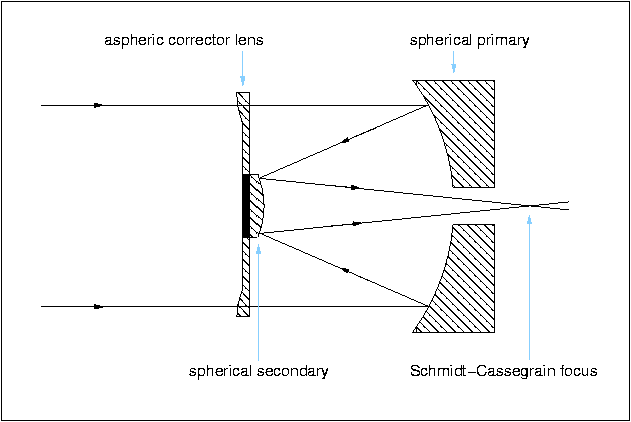
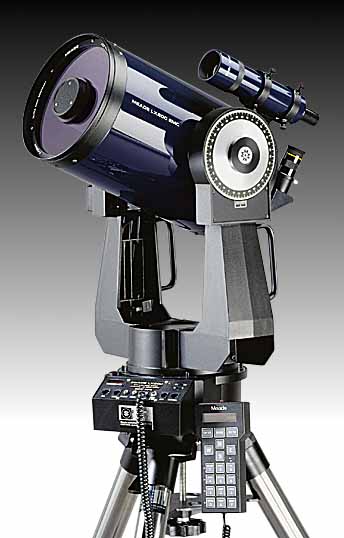
The great advantage of the Schmidt-Cassegrain design is that it is cheap to mass produce, thanks to the use of spherical mirrors. The resulting spherical aberration is dealt with by the corrector lens, a feature it borrows from the Schmidt telescope. Unlike the Schmidt telescope, however, the Schmidt-Cassegrain suffers from off-axis aberrations like coma and astigmatism because the corrector lens is not placed at the centre of curvature. The Schmidt-Cassegrain retains one of the main advantages of the Cassegrain - a long focal length in a short tube, giving a telescope which is compact and portable yet able to provide small enough plate scales for detailed planetary viewing. This versatility makes them ideal for the amateur astronomy market. The typical focal ratio of a Schmidt-Cassegrain telescope is f/10 and they are available in apertures ranging from approximately 4-16 inches. Larger apertures become impractical due to the cost of manufacturing the corrector and mounting it without flexure (especially if the secondary mirror is attached to it). An example of a Schmidt-Cassegrain telescope is shown on the right-hand side of figure 25.
Maksutov telescopes
The corrector plate in a Schmidt-Cassegrain telescope is aspherical and hence difficult to shape and polish accurately. In 1941, the Russian optician Dmitri Maksutov announced a new catadioptric design, the Maksutov telescope, which does away with the aspheric corrector and replaces it with a meniscus lens with spherical surfaces. The spherical inner face of the corrector lens has a small spot aluminized on it which acts as the secondary mirror, redirecting the light through a hole in the spherical primary, as shown on the left-hand side of figure 26. Hence such telescopes are also known as Maksutov-Cassegrains.
| figure 26: |
Left: A schematic of a Maksutov telescope. Right: A photograph of
one of the world's best-selling telescopes - a 90mm Maksutov-Cassegrain,
which currently costs about £500.
|
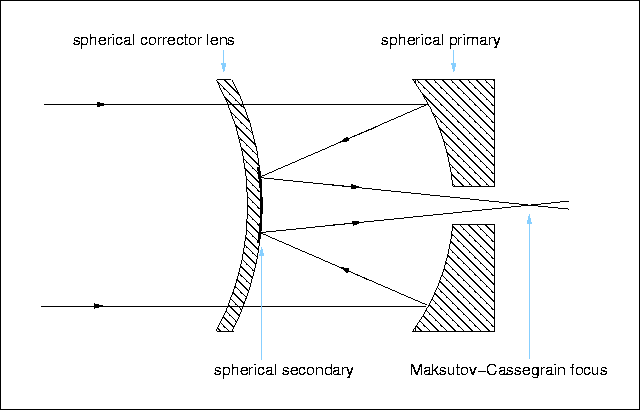
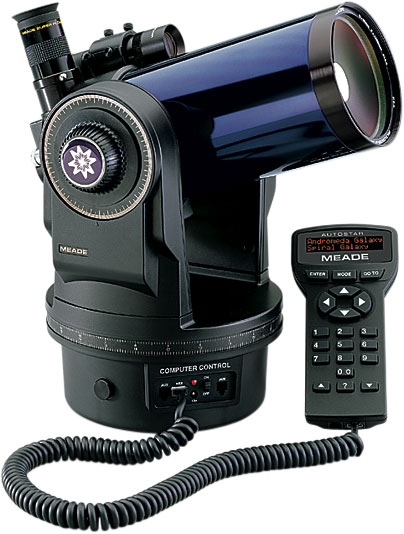
It is often said that Maksutov telescopes offer the ultimate in imaging performance. This is true to a point, as it is easier to shape and polish spherical surfaces to a high accuracy than the aspheric surfaces found in Schmidt-Cassegrain correctors. In order to minimise off-axis aberrations like coma and astigmatism, the focal lengths of Maksutovs tend to be higher than Schmidt-Cassegrain telescopes, with typical focal ratios of f/15. This results in a smaller secondary mirror and hence a reduced central obstruction, which improves image contrast. On the down-side, the slow focal ratio reduces the field of view of a Maksutov, and the deep curve and thickness of the meniscus lens becomes prohibitively expensive to manufacture and mount in large apertures. For this reason, the largest Maksutovs that can readily be purchased have only 8-inch primary mirrors.